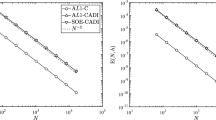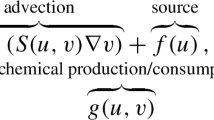Abstract
We analyze two finite volume schemes, linear and nonlinear, for the chemotaxis system in two-dimensional domain, which preserve the mass conservation and positivity without the CFL condition. For the nonlinear scheme, the well-posedness is proved by using Brouwer’s fixed point theory, and we show the convergence of the Picard iteration. We also investigate two discrete Lyapunov functionals, the asymptotic stability of equilibrium and the local stability. Moreover, we apply the discrete semi-group theory to error analysis and obtain the convergence rate \(O(\tau +h)\) in \(L^p\) norm. The theoretical results are confirmed by numerical experiments.










Similar content being viewed by others
References
Andreianov, B., Bendahmane, M., Saad, M.: Finite volume methods for degenerate chemotaxis model. J. Comput. Appl. Math. 235, 4015–4031 (2011)
Bessemoulin-Chatard, M., Chainais-Hilliairet, C., Filbet, F.: On discrete functional inequalities for some finite volume schemes. IMA J. Numer. Anal. 35, 1125–1149 (2015)
Bessemoulin-Chatard, M., Jüngel, A.: A finite volume scheme for a Keller–Segel model with additional cross-diffusion. IMA. J. Numer. 34, 96–122 (2014)
Cai, Z.: On the finite volume element method. Numer. Math. 58, 713–735 (1991)
Chamoun, G., Saad, M., Talhouk, R.: Monotone combined edge finite volume-finite element scheme for anisotropic Keller–Segel model. Numer. Methods Partial Differ. Equ. 30, 1030–1065 (2014)
Chertock, A., Epshteyn, Y., Hu, H., Kurganov, A.: High-order positivity-preserving hybrid finite-volume-finite-difference methods for chemotaxis systems. Adv. Comput. Math. 44, 327–350 (2018)
Chertock, A., Kurganov, A.: A second-order positivity preserving central-upwind scheme for chemotaxis and haptotaxis models. Numer. Math. 111, 169–205 (2008)
Childress, S., Percus, J.K.: Nolinear aspects of chemotaxis. Math. Biosci. 56, 217–237 (1981)
Chou, S., Kwak, D.Y., Li, Q.: \({L}^p\) error estimates and superconvergence for covolume or finite volume element methods. Numer. Methods Partial Differ. Equ. 19, 463–486 (2003)
Chou, S., Li, Q.: Error estimates in \({L}^2\), \({H}^1\) and \({L}^\infty \) in covolume methods for elliptic and parabolic problems: a unified approach. Math. Comput. 69, 103–120 (1999)
Crouzeix, M., Thomée, V.: Resolvent estimates in \(l^p\) for discrete Laplacians on irregular meshes and maximum-norm stability of parabolic finite difference schemes. Comput. Methods Appl. Meth. 1(1), 3–17 (2001)
Dragomir, S.S.: Some Gronwall Type Inequalities and Applications. Nova Science Publishers Inc, Hauppauge, NY (2003)
Epshteyn, Y.: Upwind-difference potentials method Patlak–Keller–Segel chemotaxis model. J. Sci. Comput. 53, 689–713 (2012)
Epshteyn, Y., Izmirlioglu, A.: Fully discrete analysis of a discontinuous finite element method for the Keller–Segel chemotaxis model. J. Sci. Comput. 40, 211–256 (2009)
Epshteyn, Y., Kurganov, A.: New interior penalty discontinuous Galerkin methods for the Keller–Segel chemotaxis model. SIAM J. Numer. Anal. 47, 386–408 (2008)
Eymard, R., Gallouët, T., Herbin, R.: Finite Volume Methods. Handbook of Numerical Analysis, vii, North-Holland, Amsterdam (2000)
Fatkullin, I.: A study of blow-ups in the Keller–Segel model of chemotaxis. Nonlinearity 26, 81–94 (2013)
Filbet, F.: A finite volume scheme for the Patlak–Keller–Segel chemotaxis model. Numer. Math. 104, 457–488 (2006)
Gajewski, H., Zacharias, K.: Global behaviour of a reaction-diffusion system modelling chemotaxis. Math. Nachr. 195, 77–114 (1998)
Grisvard, P.: Elliptic Problems in Nonsmooth Domains. Pitman, Boston (1985)
Haškovec, J., Schmeiser, C.: Stochastic p approximation for measure valued solutions of the 2D Keller–Segel system. J. Stat. Phys. 135, 133–151 (2009)
Haškovec, J., Schmeiser, C.: Convergence of a stochastic p approximation for measure solutions of the 2D Keller–Segel system. Commun. Partial Differ. Equ. 36, 940–960 (2011)
Horstmann, D.: From 1970 until present: the Keller-Segel model in chemotaxis and its consequences, I. Jahresber. Deutsch. Math.-Verein. 105, 103–165 (2003)
Horstmann, D.: From 1970 until present: the Keller–Segel model in chemotaxis and its consequences. II. Jahresber. Deutsch. Math.-Verein. 106, 51–69 (2004)
Keller, F.F., Segel, L.A.: Initiation on slime mold aggregation viewed as instability. J. Theor. Biol. 26, 399–415 (1970)
Knabner, P., Angermann, L.: Numerical Methods for Elliptic and Parabolic Partial Differential Equations. Springer, New York (2003)
Li, R., Chen, Z., Wu, W.: Generalized Difference Methods for Differential Equations, Numerical Analysis of Finite, vol. method. Marcel Dekker Inc, New York (2000)
Marrocco, A.: 2D simulation of chemotaxis bacteria aggregation. M2AN 37, 617–630 (2003)
Moser, J.: A sharp form of an inequality by N. Trudinger. Indiana Math. J. 20, 1077–1093 (1971)
Nagai, T.: Global existence of solutions to a parabolic system for chemotaxis in two space dimensions. Nonlinear Anal. Theory Methods Appl. 30, 5381–5388 (1997)
Nagai, T., Senba, T., Suzuki, T.: Chemotactic collapse in a parabolic system of mathematical biology. Hiroshima Math. J. 30, 463–497 (2000)
Okamoto, H.: On the semidiscrete finite element approximation for the nonstationary Navier–Stokes equation. J. Fac. Sci. Univ. Tokyo Sect. IA.Math. 29, 613–651 (1982)
Perthame, B.: PDE models for chemotactic movements: parabolic, hyperbolic and kinetic. Appl. Math. 49, 539–364 (2004)
Saito, N.: Remarks on the rational approximation of holomorphic semigroups with nonuniform partitions. Jpn. J. Ind. Appl. Math. 21, 323–337 (2004)
Saito, N.: Conservative upwind finite-element method for a simplified Keller–Segel system modelling chemotaxis. IMA J. Numer. Anal. 27, 332–365 (2007)
Saito, N.: Error analysis of a conservative finite-element approximation for the Keller–Segel system of chemotaxis. Commun. Pure Appl. Anal. 11, 339–364 (2012)
Saito, N., Suzuki, T.: Notes on finite difference schemes to a parabolic–elliptic system modelling chemotaxis. Appl. Math. Comput. 171, 72–90 (2005)
Strehl, R., Sokolov, A., Kuzmin, D., Turek, S.: A flux-corrected finite element method for chemotaxis problems. Comput. Methods Appl. Meth. 10, 219–232 (2010)
Suzuki, T.: Free Energy and Self-interacting Particles. Birkhauser, Boston (2005)
Thomée, V.: Galerkin Finite Element Methods for Parabolic Problems. Springer, Berlin (2006)
Varga, R.S.: Matrix Iterative Analysis. Springer, Heidelberg (2000)
Winkler, M.: Aggregation vs. global diffusive behavior in the higher-dimentional Keller–Segel model. J. Differ. Equ. 248, 2889–2905 (2010)
Yagi, A.: Norm behaviour of solutions to a parabolic system of chemotaxis. Math. Jpn. 45, 241–256 (1997)
Zhou, G., Saito, N.: Finite volume methods for a Keller–Segel system: discrete energy, error estimates and numerical blow-up analysis. Numer. Math. 135, 265–311 (2017)
Author information
Authors and Affiliations
Corresponding author
Additional information
Publisher's Note
Springer Nature remains neutral with regard to jurisdictional claims in published maps and institutional affiliations.
The author was supported by the research fund from University of Electronic Science and Technology of China and by NSFC (No. 12071061)
Rights and permissions
About this article
Cite this article
Zhou, G. An Analysis on the Finite Volume Schemes and the Discrete Lyapunov Inequalities for the Chemotaxis System. J Sci Comput 87, 54 (2021). https://doi.org/10.1007/s10915-021-01466-3
Received:
Revised:
Accepted:
Published:
DOI: https://doi.org/10.1007/s10915-021-01466-3




